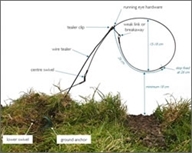Responsibility
Under all legislation relating to wild animals and snares, the responsibility rests with you – the snare operator – not with your employer, your supplier, the snare manufacturer or any advisor. As a snare user it is you that is open to prosecution for malpractice.
Legitimate use
In all parts of the UK, snares may be set to catch foxes, rabbits and brown hares, provided you are the landowner or have the landowner’s permission. (You can also legally snare a few other species such as rats and mink, though we would generally advocate other methods for controlling these species.)
Statutes affecting snare use
The Wildlife & Countryside Act (1981) and Wildlife (Northern Ireland) Order 1985 impose certain conditions (described later) on the use of snares, for conservation reasons, and prohibit their use to catch species of conservation concern that are listed in Schedules 5 and 6 of the Act. These schedules are not fixed: they can be altered by the Secretary of State. As they stand at present, protected animals at risk of capture in fox snares include badger, wild cat, pine marten, otter and just conceivably polecat and hedgehog. The Deer Act 1991 and the Deer (Scotland) Act 1996 prohibit the use of snares to take deer.
In Scotland, extra restrictions and conditions on the use of snares were introduced by the Nature Conservation (Scotland) Act 2004, the Conservation (Natural Habitats, &c.) Amendment (Scotland) Regulations 2007, and the Snares (Scotland) Order 2010. These statutes dictate certain working practices as well as restricting use, and reflect a mixture of conservation and humaneness concerns. The Wildlife & Natural Environment (Scotland) Act (WANE) became law in 2011, making accreditation and training of all snare users a legal requirement in Scotland, following the enactment of The Snares (Training) (Scotland) (No.2) Order 2012. Once accredited, snare operators must apply with their certificate to their local police station for an individual ID number which must be tagged onto every fox and rabbit snare.
Accreditation courses are run by Scottish Government approved bodies, which include the Game & Wildlife
Conservation Trust (GWCT), the Scottish Gamekeepers’ Association (SGA) and the British Association for Shooting and Conservation (BASC) Scotland.
Under the WANE Act, record keeping became a legal requirement from April 2013. Snare users need to record the location of every snare currently set; the location of every snare set in position by the operator within the past two years (not applicable to snares prior to ID issue); the date on which each snare was set; the date on which each snare was removed; the type of animal caught and the date it was found. Keeping records will not only become a legal requirement in Scotland, they will also be for the practitioner’s own benefit and protection, particularly in the event of any incidents. It demonstrates you are a responsible person. It may be an offence to deliberately snare mountain (blue) hares if this disturbs or significantly reduces the local population.
The Animal Welfare Act (2006) and Animal Health and Welfare (Scotland) Act (2006) affect all use of traps and snares. This Act makes the operator responsible to avoid the unnecessary suffering of any captured animal. The Act was not intended to obstruct accepted management practices, responsibly carried out. The best way to demonstrate that you are taking responsible measures to avoid unnecessary suffering is to follow an official Code of Practice.
Codes of practice
We urge you to read, understand and follow the relevant Code of Practice (CoP). In England and Wales this is the Defra Code of Practice on the Use of Snares. The Defra CoP, published in 2005 and revised in 2012, is based on the Report of the Independent Working Group on Snares (IWGS), a multi-interest group convened at the request of Defra specifically to construct a CoP. The IWGS included representatives from the GWCT, BASC and the National Gamekeepers’ Organisation (NGO), alongside vets and animal welfare specialists. The IWGS Report (also available as a download from the Defra website) brought together all the evidence available at that time concerning the use of snares in the UK.
In Scotland, operators should follow the guidelines described in the fourth edition of Snaring in Scotland: A Practitioners’ Guide (which we refer to in these pages as the Scottish CoP). This guide, dated 2012, remains current Scottish Practitioners’ Guidelines and was produced by a consortium of bodies including the GWCT, BASC (Scotland) and the SGA at the request of the Scottish Government.
The CoPs are equivalent to the Highway Code in motoring. It is not mandatory to follow a CoP, nor does it provide indemnity against prosecution – but it will make your position simpler for the police to investigate if they need to, and makes a strong defence should the matter nevertheless come to court. If you deviate from the relevant CoP, you should have a strong justification for doing so because it may well be tested in court.
Besides urging you to follow the relevant CoP, we also recommend that you keep detailed records of your snaring effort (e.g. a map of where your snares are set and a diary of how many snares are set each day) and also records of what you catch. Also keep records of any training courses you have attended. These records would be helpful if you were ever faced with an investigation or prosecution.
Get your FREE fox snaring guide from the GWCT team
Simply enter your email address below to download your essential free guide.
 What's inside your FREE fox snaring guide
What's inside your FREE fox snaring guide
✓ Fox control: Is it important?
✓ What are the alternatives to snaring?
✓ The main components of a well-designed snare
✓ Fox snares: Hardware vs practice
✓ Key controversies
Download free >